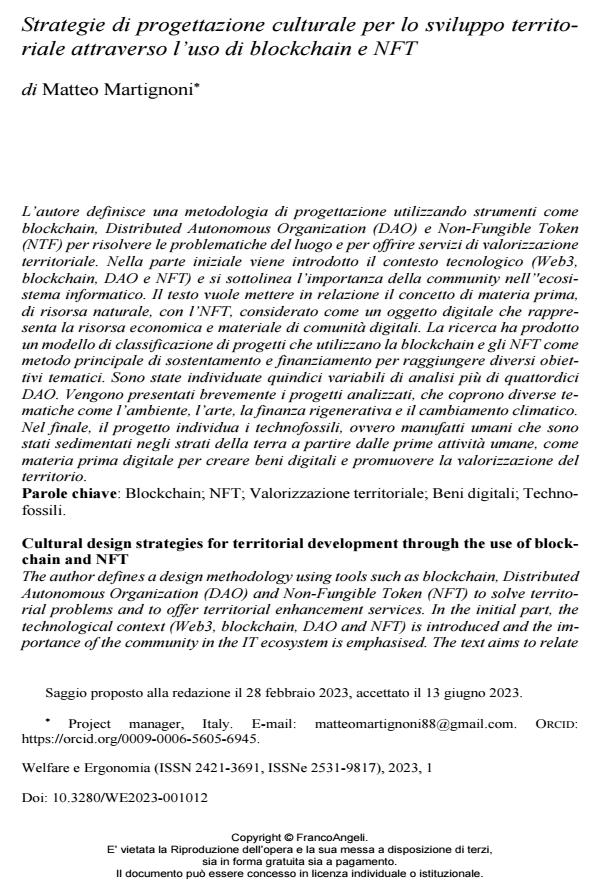Strategie di progettazione culturale per lo sviluppo territoriale attraverso l’uso di blockchain e NFT
Titolo Rivista WELFARE E ERGONOMIA
Autori/Curatori Matteo Martignoni
Anno di pubblicazione 2023 Fascicolo 2023/1
Lingua Italiano Numero pagine 11 P. 167-177 Dimensione file 233 KB
DOI 10.3280/WE2023-001014
Il DOI è il codice a barre della proprietà intellettuale: per saperne di più
clicca qui
Qui sotto puoi vedere in anteprima la prima pagina di questo articolo.
Se questo articolo ti interessa, lo puoi acquistare (e scaricare in formato pdf) seguendo le facili indicazioni per acquistare il download credit. Acquista Download Credits per scaricare questo Articolo in formato PDF

FrancoAngeli è membro della Publishers International Linking Association, Inc (PILA)associazione indipendente e non profit per facilitare (attraverso i servizi tecnologici implementati da CrossRef.org) l’accesso degli studiosi ai contenuti digitali nelle pubblicazioni professionali e scientifiche
L’autore definisce una metodologia di progettazione utilizzando strumenti come blockchain, Distributed Autonomous Organization (DAO) e Non-Fungible Token (NTF) per risolvere le problematiche del luogo e per offrire servizi di valorizza-zione territoriale. Nella parte iniziale viene introdotto il contesto tecnologico (Web3, blockchain, DAO e NFT) e si sottolinea l’importanza della community nell’‘ecosistema informatico. Il testo vuole mettere in relazione il concetto di ma-teria prima, di risorsa naturale, con l’NFT, considerato come un oggetto digitale che rappresenta la risorsa economica e materiale di comunità digitali. La ricerca ha prodotto un modello di classificazione di progetti che utilizzano la blockchain e gli NFT come metodo principale di sostentamento e finanziamento per raggiun-gere diversi obiettivi tematici. Sono state individuate quindici variabili di analisi più di quattordici DAO. Vengono presentati brevemente i progetti analizzati, che coprono diverse tematiche come l’ambiente, l’arte, la finanza rigenerativa e il cambiamento climatico. Nel finale, il progetto individua i technofossili, ovvero manufatti umani che sono stati sedimentati negli strati della terra a partire dalle prime attività umane, come materia prima digitale per creare beni digitali e pro-muovere la valorizzazione del territorio.
Parole chiave:Blockchain; NFT; Valorizzazione territoriale; Beni digitali; Tech-nofossili.
- Almeida G.G.F. and Cardoso L. (2022). Discussions between Place Branding and Territorial Brand in Regional Development – A Classification Model Proposal for a Territorial Brand. Sustainability, 14: 6669.
- Anholt S. (2010). Definitions of place branding – Working towards a resolution. Place Branding and Public Diplomacy, 6(1): 1-10.
- Bardari G., Cioppa M., Martignoni M. e Moricola B. (2022). San Giovanni a Teduccio: verso una nuova industria culturale, Stati Generali del Patrimonio Industriale. Venezia: Marsilio.
- Eskiev M.A. (2021). Territory branding as an opportunity for the region development, International Scientific Conference «Social and Cultural Transformations in the Context of Modern Globalism», -- https://www.europeanproceedings.com/article/10.15405/epsbs.2021.11.70.
- McLuhan M. (1967). Gli strumenti per comunicare. Milano: Il Saggiatore.
- Qin W., Rujia L., Qi W., Shiping C., Mark R. and Thomas H. (2022). Exploring Web3 From the View of Blockchain, MIT Connection Science, Massachusetts Institute of Technology, USA, Southern University of Science and Technology, China, University of Birmingham, United Kingdom, CSIRO Data61, Australia.
Matteo Martignoni, Strategie di progettazione culturale per lo sviluppo territoriale attraverso l’uso di blockchain e NFT in "WELFARE E ERGONOMIA" 1/2023, pp 167-177, DOI: 10.3280/WE2023-001014